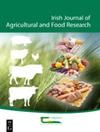Lipid and protein oxidation and colour stability during display in high oxygen modified atmosphere packaging of beef from late-maturing bulls fed rumen protected fish oil
IF 1.4
4区 农林科学
Q3 AGRICULTURE, MULTIDISCIPLINARY
引用次数: 0
Abstract
Increasing the concentration of polyunsaturated fatty acids (PUFA) in beef enhances its nutritional value but may compromise its oxidative shelf life. In this experiment, the impact of inclusion of rumen protected fish oil (PFO) in the finishing diet of late-maturing bulls on muscle fatty acid profile, antioxidant content, lipid stability, colour and protein oxidation was investigated. Charolais-sired suckler bulls were offered ad libitum, for 101 d pre-slaughter, a barley-based concentrate (C) or a concentrate containing rumen PFO. Following post-mortem ageing for 14 d, M. Longissimus thoracis muscle was subjected to simulated retail display (4°C, 1,000 lux for 12 h out of 24 h) for 3, 7 and 10 d in modified atmosphere packs (O2:CO2; 80:20). The concentrations of C22:6n-3, n-6 PUFA and total PUFA and the n-6:n-3 PUFA ratio were higher (P < 0.001) in muscle of PFO bulls compared to C bulls, while the α-tocopherol concentration was lower (P < 0.01). The concentrations of C18:3n-6, C20:4n-6, n-3 PUFA and highly peroxidisable PUFA were lower (P < 0.05) on day 14 compared to day 0 of display. Lipid oxidation after 10 d of display was higher (P < 0.05) in muscle of PFO bulls compared to C bulls but not to an extent that would be detected by a consumer. Colour stability was not affected. It is concluded that the increase in PUFA concentration achieved had minor effects on bull beef shelf life.饲喂瘤胃保护鱼油的晚熟公牛牛肉在高氧修饰气氛包装中的脂质和蛋白质氧化及颜色稳定性
增加牛肉中多不饱和脂肪酸(PUFA)的浓度可以提高其营养价值,但可能会影响其氧化保质期。在本实验中,研究了在晚熟公牛的精加工日粮中加入瘤胃保护鱼油(PFO)对肌肉脂肪酸组成、抗氧化剂含量、脂质稳定性、颜色和蛋白质氧化的影响。在屠宰前101天,随意向夏洛莱父系乳牛提供大麦基浓缩物(C)或含有瘤胃PFO的浓缩物。死后老化14天后,在改良的空气包(O2:CO2;80:20)中对胸最长肌进行模拟零售展示(4°C,1000勒克斯,24小时中的12小时)3、7和10天。与C公牛相比,PFO公牛肌肉中C22:6n-3、n-6 PUFA和总PUFA的浓度以及n-6:n-3 PUFA的比率较高(P<0.001),而α-生育酚的浓度较低(P<0.01)。与C公牛相比,PFO公牛在展示10天后肌肉中的脂质氧化更高(P<0.05),但没有达到消费者可以检测到的程度。颜色稳定性没有受到影响。结果表明,PUFA浓度的增加对牛肉的保质期影响较小。
本文章由计算机程序翻译,如有差异,请以英文原文为准。
求助全文
约1分钟内获得全文
求助全文
来源期刊
CiteScore
2.50
自引率
20.00%
发文量
23
审稿时长
>36 weeks
期刊介绍:
The Irish Journal of Agricultural and Food Research is a peer reviewed open access scientific journal published by Teagasc (Agriculture and Food Development Authority, Ireland). Manuscripts on any aspect of research of direct relevance to Irish agriculture and food production, including plant and animal sciences, food science, agri environmental science, soils, engineering, buildings, economics and sociology, will be considered for publication. The work must demonstrate novelty and relevance to the field of research. Papers published or offered for publication elsewhere will not be considered, but the publication of an abstract does not preclude the publication of the full paper in this journal.

 求助内容:
求助内容: 应助结果提醒方式:
应助结果提醒方式:


